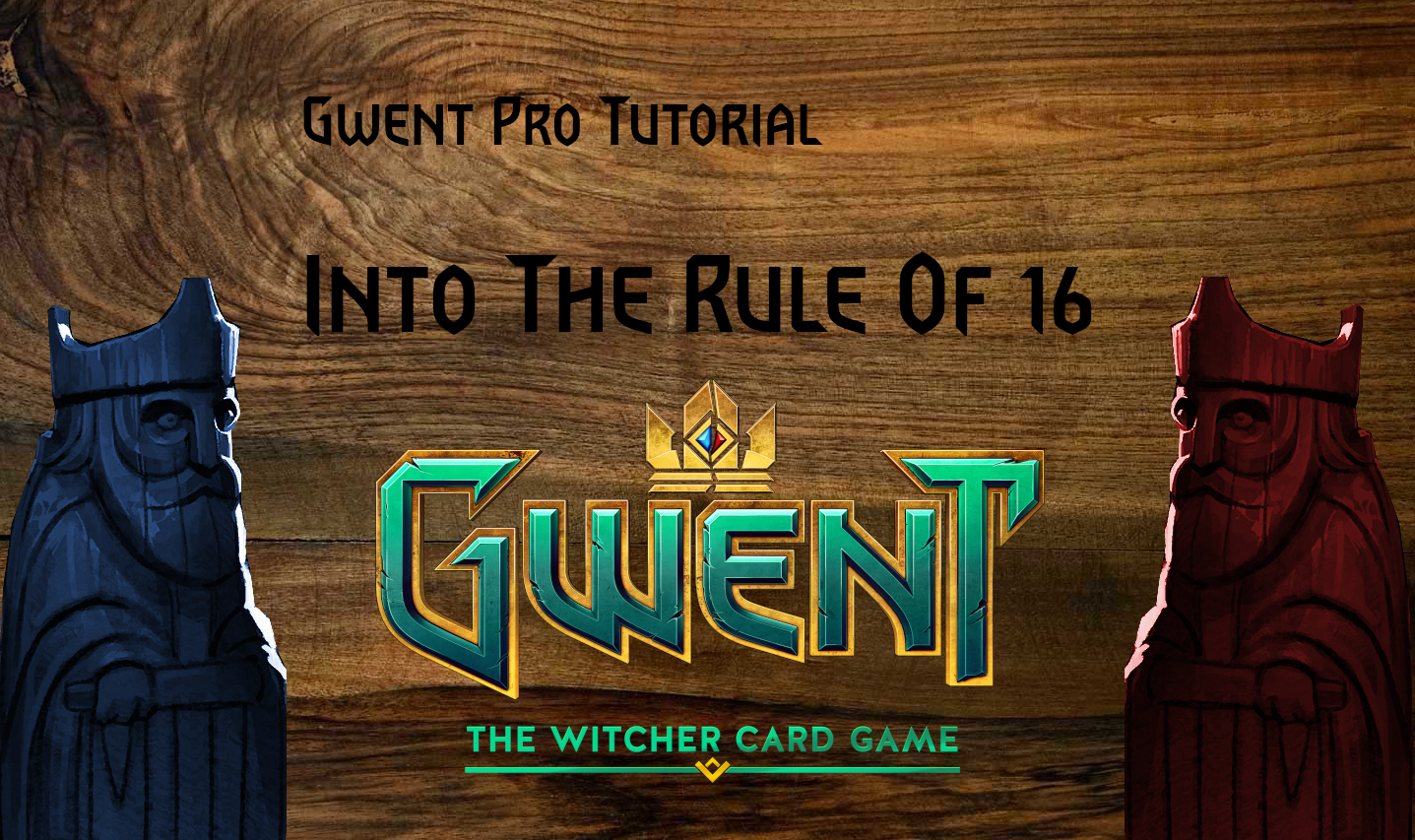Introduction
The Rule Of 16 is probably the best known deckbuilding rule in Gwent: The Witcher Card game containing a number. Don’t worry if you haven’t come across it yet – here is the crucial Youtube presentation by Gorflow and the author of the term – Condor.
The concept obviously had been common knowledge amongst competitive Gwent players before vod release, but probably nobody tried to systemize and present it in a detailed, comprehensive way.
In this tutorial we would revisit the Rule of 16 and split it into another two numbers.
The Basic Rule Of 16
What part of the deck do you effectively use in a game of Gwent? In each normal, full game of Gwent, 16 cards are played from both sides. It means that the maximum number of resources (provisions) has to be invested in those cards to generate the maximum possible value.
Therefore, 4p cards in your deck have an useful role even if objectively underwhelming and you should include enough of them (about 25-16=9) to provide resource space for the 16 you actually want to play.
For the detailed insight into the basic rule I refer you once again to examples clearly explained in the original vod.
The purpose, or 16 = 10 + 6
The Rule of 16 deals with the deckbuilding economy. To expand it further for practical purposes, we have to find out how optimally alocated provisions would be exactly used to win the game.
Amongst two players who built a deck according to the rule of 16, who would win the long round 3? The one who has stronger team of 10 target cards dedicated for R3 (probably because of investing more provision points).
Assuming that those 10 target cards would be saved by both players, who would get round control after R1? The player who has stronger team of 6 target cards dedicated for R1.
Therefore a deck of cards in Gwent could be viewed as a couple of two teams. Both of these teams has to be highly synergistic internally, while external synergy is secondary, but also important – it offers better consistency and flexibility of the deck.
Let’s call the teams according to their objectives:
a) Execution Team (10+)
b) Preparation Team (6+)
Execution Team (10)
Execution Team (ET) is the set of 10 cards used to win the game after Round 1/Round 2 preparation phase. While we introduced it starting from the strict 10 cards long round picture, in fact execution cards may be played also during Round 2 push. Similarily, the boundary between Preparation/Execution teams is not rigid – one card may belong to both teams.
The first step to build a deck is to find and construct the Execution Team! (remember the last one of Deckbuilding Lifehacks?). Finding means spotting the possible win condition amongst cards in the pool. Constructing means building the Execution Team to support this idea.
Preparation Team (6)
Preparation Team (PT) leads the way for the Execution Team to be most effective. The exact purposes may vary (also depending on matchups), but the main ones are:
1) Establishing round control (winning R1).
2) Helping in R2 push (especially soft-bleed) or defending the bleed with least Execution Team commitment.
3) Shortening R2.
4) Establishing carryover.
The split into Preparation and Execution Teams should not be mistaken with high/low provision cards split. For example in a Renfri Gang spam decks (Gwent 10.9), Preparation Team includes King Foltest and Donimir of Troy, which are expensive golds.
Examples from Gwent 10.9 Meta
Let’s briefly break down four non-Nekker decks from the recent Top64 Qualifier for Gwent Open #3 of Masters 4 with respect to Execution/Preparation teams.

The Execution Team (ET) includes above all Mysteries of Loc Feiann scenario which is the crucial card around which ET is build. Lake Guardian is the strongest card possible Harmony card (procing scenario) and a strong finisher at the same time. The general win con is a long round with scenario and Harmony engines. When undisturbed, the deck is capable of creating above 200 proactive points in a long round.
The Preparation Team (PT) main objective is getting round control, which will ensure a long round with Mysteries. Saskia would usually be played in R1 for this purpose, while also providing the deck with necessary thinning to increase the chances of finding high end golds, especially Mysteries.
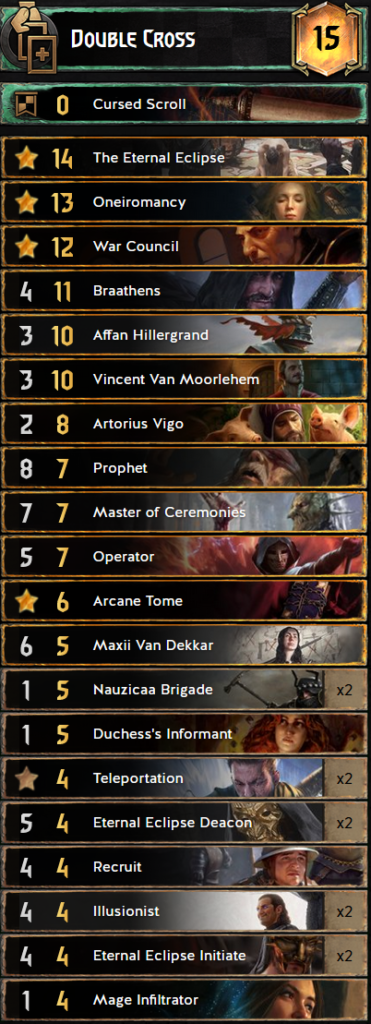
ET is build around powerful The Eternal Eclipse scenario, which could be activated in one turn by Affan Hillergrand infused with Cultist tag after the leader ability is used. In this case the boundary between ET and PT is fluid – Scenario would usually be commited early when defending bleed in R2, which makes it also PT tool in a sense. On the other hand, Operator is clearly a ET card, enabling snowball multiplication of Cultists, which is main win condition after Scenario commitment.
The deck is meant to be played mostly from red coin, and PT is oriented on carryover, with 2xDeacon + 2x Teleportation package infusing units in hand and deck with as many cultist tags as possible.
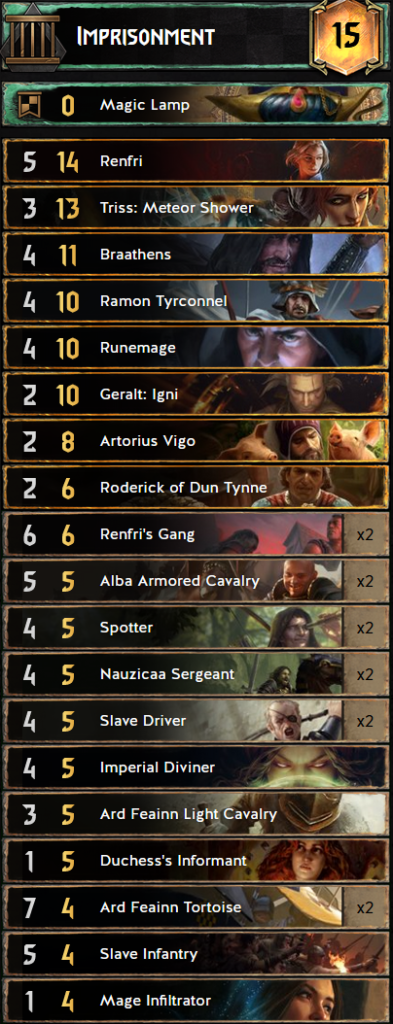
Execution Team win-con idea is based on Triss: Meteor Shower and copying of Nauzicaa Seregeants (with Ramon, Slave Drivers, Artorius Vigo into SD…), while procing Assimilate value of Artorius nad Braathens. Renfri is the strongest card in the deck, which could be played both in ET and PT. In PT Renfri could be used for passive Blessing if found in R1/R2 preferably after Runemage had been played. Especially Blessing of Kindness is standalone another win condition.
But for Nauzicaa Sergeants, the deck is rather fluid, with many ET pieces commitable for PT purpose. The usual objective of PT is to threat round control, while shortening incoming R3 to mid level. The deck is also weakly polarized, which incentivize trading opponent’s gold cards rather than passive play.
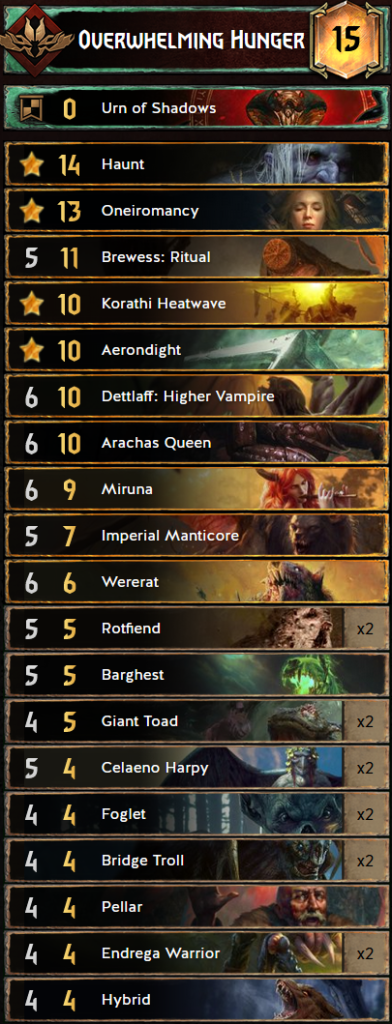
ET is based on Haunt as consume supply and Dettlaff:Higher Vampire + Arachas Queen combo as the main source of points.
PT is focused on seizing round control with removal Deathwish cards (Manticore, Rotfiends, Miruna), while Oneiromancy+Giant Toads could play for carryover after point lead is secured.
The deck is meant to be played from blue coin in the tournament setting.
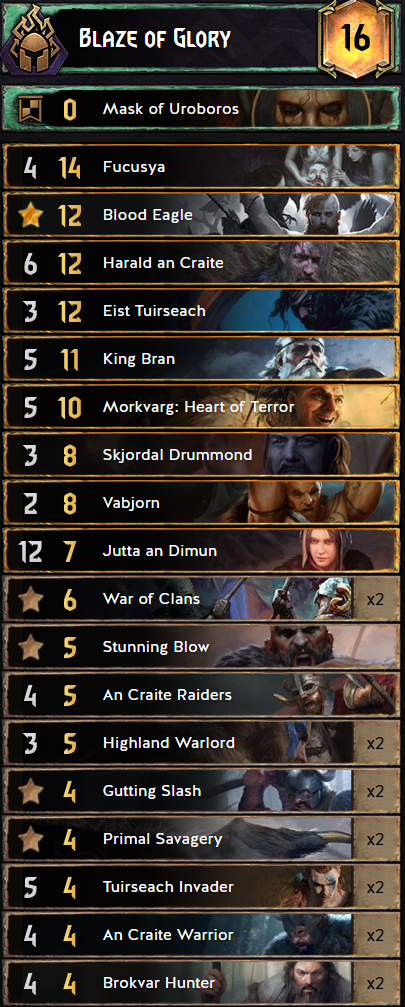
The ET is built on three high-end cards: Fucusya, Harald an Craite and especially Eist Tuirseach. Morkvarg provides green power control just in case. ET includes also raid cards, especially War of Clans.
The PT is strongly oriented on raid carryover with Highland Warlords and 4p bronze Warriors as WoC targets. Therefore the deck is meant to be played from red coin, where carryover could be gained without the risk of losing on even cards.
Deckbuilding Workflow
- Find a win-con idea and crucial cards which would be the base for ET.
- Think of 10 ET cards played in sequence, including the crucial ones you chosen. What choice of cards would maximize the effective value? Put those cards into deck. Are some cards absolutely outstanding in terms of value in your build? Consider adding a tutor for them.
- What type of PT would support your ET in the best way? In the case you play a combo deck or a last say finisher (like Regis:Reborn or Harald Gord), you would have to invest a lot in PT to ensure round control. Consider cutting least necessary ET elements. On the other hand, if you are strong in a long round and hard to bled out at the same time, maybe PT should be focused mostly on carryover? Put 6 PT cards into the deck.
- Obviously, you would seldomly get exact 6 PT cards at early stage and exact 10 ET cards later on. The remaining 9 cards should support both teams at minimal cost (think of subs in sports games). Also the more cards could be swapped between PT/ET, the better flow deck would have and more player’s agenda. (think of Redrame’s Double Scenario Guerilla as a deck having trouble in this regard)
- Practice and optimize your deck, especially against main meta builds if striving for fresh competitive list.
Closure
Thanks for reading! Hope this short tutorial to general Gwent deckbuilding principles would broaden your view and bring new ideas. Don’t follow the presented principles in a rigid way – try to understand the underlying mechanics instead. Have fun!

